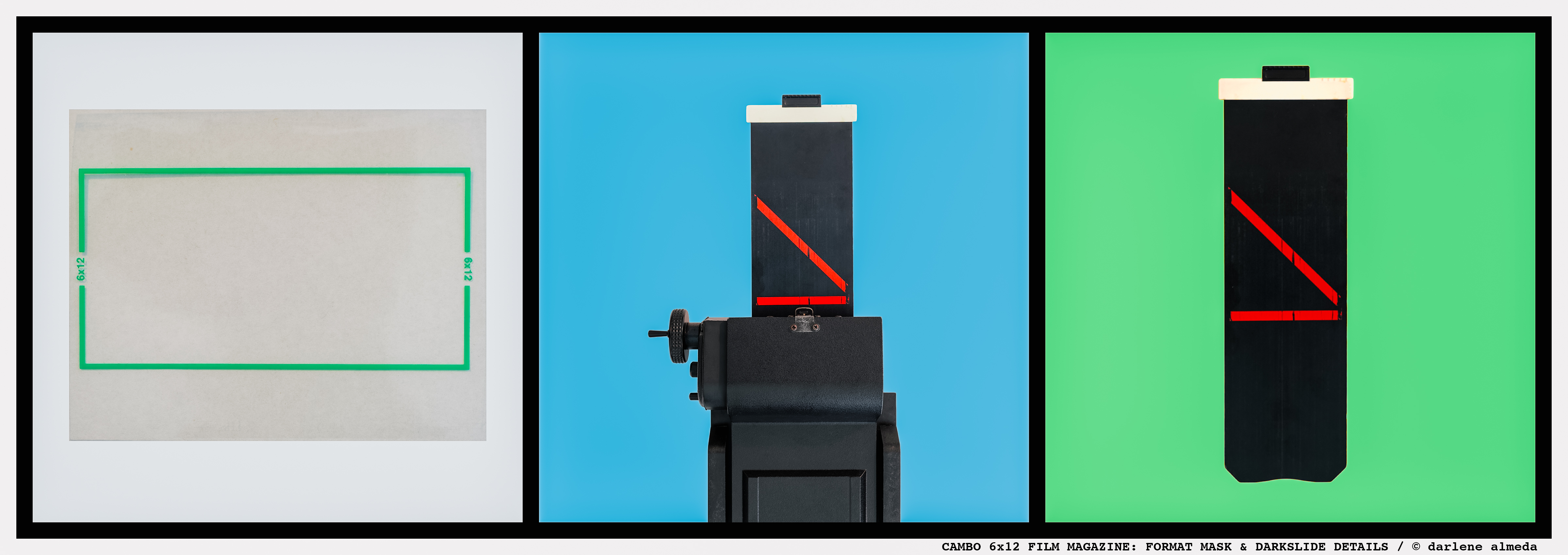CAMBO 6×12 FILM MAGAZINE
Intro
Cambo C-243 (C2N) 6×12 Roll Film Holder Overview

Build Quality & Field Handling
CAMBO 6×12 FILM MAGAZINE: MASK & DARKSLIDE
My used C-243 came with the original ground glass mask, but if yours didn’t, don’t panic—it’s easy to DIY your way out of it. Two strips of masking tape on the ground glass or a 6×12 cut-out from black construction paper will do just fine. Want to get fancy? Place the magazine on a copy machine, make a copy, cut out the film gate, and trim it to match your camera’s ground glass. Voilà—a custom template. Lay that on some black paper, cut out the window, trim the edges, and you’ve got yourself a precision mask worthy of applause.
The C-243’s build is solid without being overly heavy. In contrast, the heaviest 6×12 back I’ve used was the Linhof Rollex, which I eventually sold, partly because it didn’t fit my Ebony RSW, and partly because it felt like anchoring a boat. Even if it had fit, I suspect the poor RSW would’ve done a wheelie from the rear weight. Compared to the Rollex, the C-243 feels refreshingly light. However, considering its sturdy construction, I’d place it in the medium-weight category compared to other 6×12 magazines I’ve owned. It strikes a nice balance between durability and manageability.
I’ve used the C-243 in the studio with my Ebony RW and in the field with the Cambo Wide 650. It slides in behind the ground glass with ease—no wrestling or weird wrist angles required. As always with 4×5 holders, I take care not to bump the camera or shift the back, because nothing kills the mood like recomposing from scratch. So far, the C-243 has been a smooth operator.
Now let’s talk darkslide. This one comes with a stylish red pattern that makes it easy to tell when it’s pulled out—unless, of course, you’re like me on the first roll and don’t pull it out quite far enough. I’m not a fan of removing it completely (maybe you’re more daring), so I stopped just shy of the danger zone—or so I thought. What I ended up with was a faint line across the extreme right side of the negative, with a ruffled edge that looked suspiciously like the trim on the dresses my mother dressed me in as a kid. And let’s be clear: the only ruffles I willingly embrace these days come in a bag labeled potato chips. Lesson learned. Since then, no more frills—just clean, crispy negatives.
Film Loading
CAMBO 6×12 FILM MAGAZINE FILM LOADING
Loading film into the C-243 isn’t especially hard, at least not compared to some of the more temperamental film backs I’ve wrestled with. That said, don’t zone out while you’re winding. The backing paper pulls out a lot, and if you get too enthusiastic (as I did on roll two), you’ll end up with a final frame that’s not the full frame size.
To spare you from trial and error, I’ve included a link to a YouTube video that walks through the process using a Calumet C-2 film magazine (which is basically a Cambo in disguise). The demo is for a 6×7 format, but the steps apply just as well to the 6×12.
And because the internet is oddly silent on this topic, I’ve also scanned and included the original C-243 loading instructions and component diagram. Watch the video for the how, and consult the PDFs for the what and why.
Film Advance & Frame Count
CAMBO 6×12 FILM MAGAZINE FILM ADVANCE POSITIONS
The C-243 uses a mechanical frame counter dial—no red windows or peepholes here. To load, set the dial to the neutral “freewheeling” position (check the PDF if you’re unsure), and wind the film until the frame locating mark—a red dot—lines up between last frame and “S”. Once the back is closed and the darkslide is properly inserted, turn the advance knob until it stops. That’s your first frame, and you’re ready to go.
Advancing to the next frame is just as straightforward. After each shot, press the release button and turn the advance knob until it clicks to a stop. No need to squint at frame numbers through a window—each position locks into place with a satisfying Cambo-style precision. Just remember to press the release first—otherwise, you’ll be spinning the knob like a confused tourist on a New Jersey roundabout.
After exposing all six frames (or twelve if you’re using 220 film), continue winding to spool off the paper backing. You’ll feel the resistance ease up—that’s your cue that the film is fully wound. You can then open the back and remove the film for processing.
FINAL THOUGHTS
ORCHIDS: EBONY RW + CAMBO 6×12 + SK 120M + TMAX 100
The C-243 is, hands down, the best 6×12 film back I’ve used to date. And I don’t say that lightly—I’m comparing it directly to the Horseman, the Linhof Rollex, and the Da Yi 6×12 (which, frankly, deserves its own category titled Frustration).
Of course, that’s just my take based on how I shoot and what matters to me. Let me explain why this back stands out…
PROS:
1. Ease of Use:
One of the most significant advantages is that the ground glass does not have to be removed which means my viewfinder can stay on the camera. If you’re using a Graflok system, this back fits right in there, too. It’s flexible and practical.
2. Weight:
This back won’t give you a hernia. It’s noticeably lighter than the Linhof Rollex, which feels like it was forged from melted-down tank parts.
3. Frame Spacing:
Zero spacing issues. That’s right—zero. Every frame lines up cleanly, with none of the weird overlaps or crowding I’ve seen on other backs.
CONS:
Honestly, I haven’t found any true cons—yet. The only “gotchas” came from my early learning curve: figuring out how much of the darkslide needs to be pulled (answer: all the way, don’t get cute), and how far to advance the film leader without compromising that last frame. These are user quirks, not design flaws.
I’ve now run about half a dozen rolls through this back—both on my Cambo Wide 650 and behind my custom bag viewer on my Ebony—and I’ve had zero issues with film flatness, frame spacing, or overall operation. It’s a solid performer that quietly does exactly what it’s supposed to. No fuss, no surprises, no drama.





